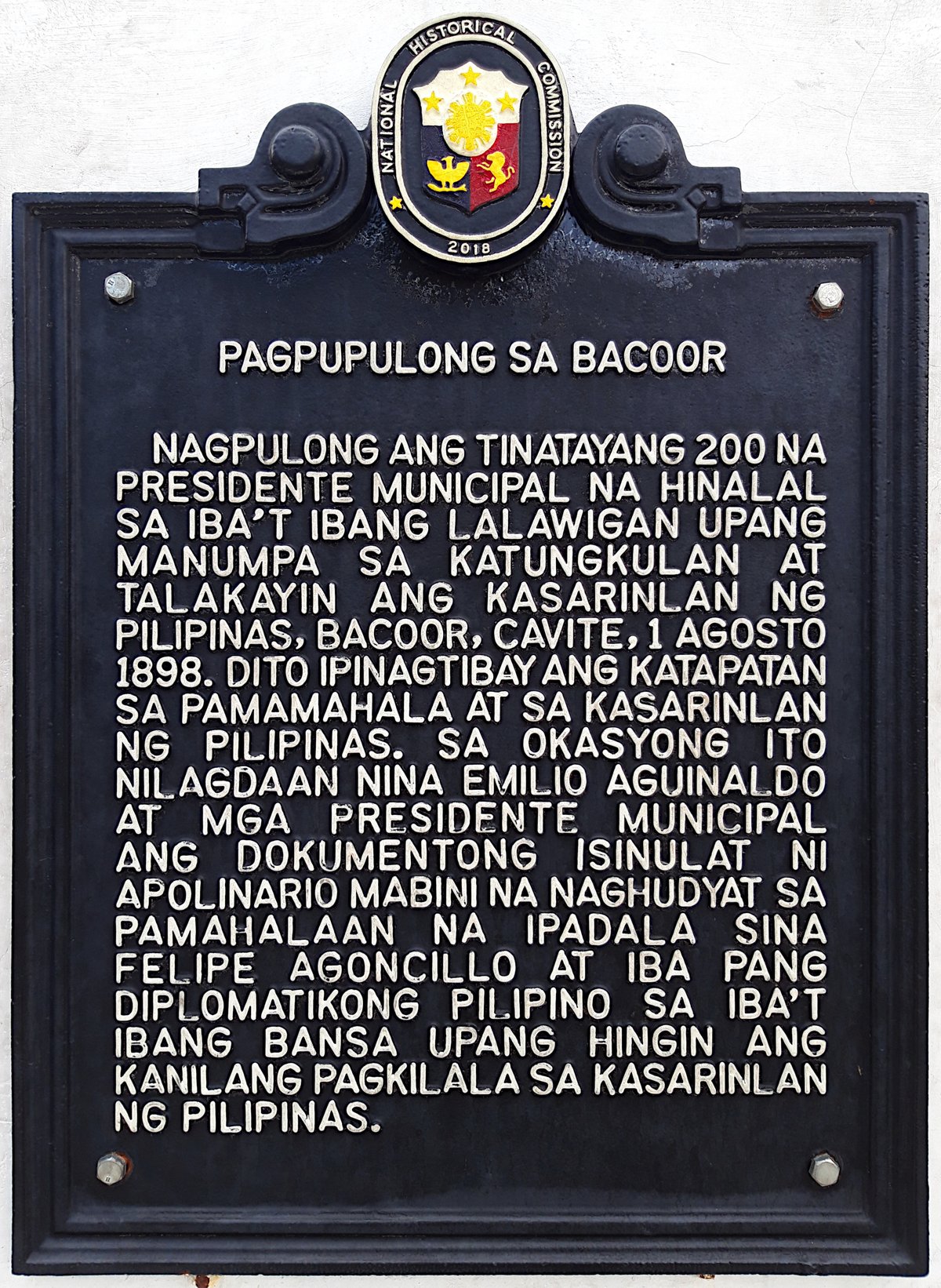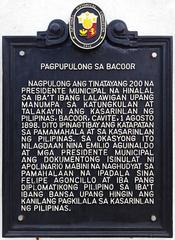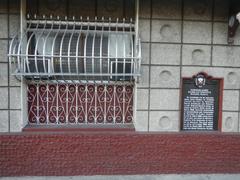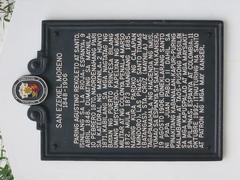
Bacoor Assembly Historical Marker: Visiting Hours, Tickets, and Travel Guide
Date: 14/06/2025
Introduction
The Bacoor Assembly Historical Marker, together with the iconic Cuenca Ancestral House (Bahay na Tisa), stands as a testament to Bacoor, Cavite’s pivotal role in the Philippine Revolution. These sites not only commemorate the ratification of the nation’s independence but also anchor Bacoor’s enduring identity as a center of cultural heritage and community pride. This guide provides comprehensive information on the marker’s historical significance, visiting hours, admission, accessibility, nearby attractions, and travel tips—ensuring an enriching and seamless visit for history enthusiasts, students, and travelers alike.
(Senate Quick Notes, 2024; PNA, 2018; Manila Bulletin, 2024; Trip the Islands; Bacoor City Government; St. Dominic College of Asia)
Table of Contents
- Historical Context: The Bacoor Assembly and Its Legacy
- Visiting the Bacoor Assembly Historical Marker and Cuenca Ancestral House
- Nearby Historical Sites and Attractions
- Travel Tips and Practical Information
- Cultural Highlights and Community Life
- Frequently Asked Questions (FAQs)
- Visual Highlights and Media
- Conclusion and Next Steps
- Sources and Further Reading
Historical Context: The Bacoor Assembly and Its Legacy
The Bacoor Assembly, held on August 1, 1898, in Bacoor, Cavite, was a historic gathering of around 200 municipal leaders from sixteen provinces liberated from Spanish rule. Presided over by General Emilio Aguinaldo and shaped by Apolinario Mabini’s vision, the assembly ratified a revised Act of Independence that removed references to foreign protectorate status. This act marked a critical consolidation of national will and asserted the Philippines’ sovereign identity, paving the way for its recognition both at home and abroad.
The Cuenca Ancestral House, also known as Bahay na Tisa, was the site of this assembly and served as the seat of the revolutionary government before the capital moved to Malolos. Today, the house and its historical marker at Plaza de Mariano Gomez provide a tangible link to this formative moment in the nation’s history (Senate Quick Notes, 2024; PNA, 2018).
Visiting the Bacoor Assembly Historical Marker and Cuenca Ancestral House
Location and Accessibility
- Bacoor Assembly Historical Marker: Located at Plaza de Mariano Gomez in Bacoor City, Cavite—approximately 15 km southwest of Manila and easily reachable via Emilio Aguinaldo Highway, CAVITEX, and public transport routes (Moovit).
- Cuenca Ancestral House (Bahay na Tisa): Situated near the plaza and the Bacoor Government Center, this Spanish-era residence is the centerpiece of Bacoor’s revolutionary heritage.
How to Get There:
- Public Transport: Buses and jeepneys from Metro Manila (Lawton, Baclaran) regularly stop in Bacoor. From the drop-off points, tricycles can take you directly to the site.
- Private Vehicle: Ample parking is available near government buildings and commercial establishments, though it may be limited during major events.
Visiting Hours and Tickets
- Bacoor Assembly Historical Marker:
- Hours: Open 24/7 as an outdoor public monument.
- Admission: Free of charge.
- Cuenca Ancestral House (Bahay na Tisa):
- Hours: Tuesday–Sunday, 9:00 AM–5:00 PM.
- Tickets: ₱50 for adults, ₱25 for students and seniors.
Guided Tours and Educational Programs
- Guided Tours: Available through the Bacoor Historical Society and local tourism offices, particularly during commemorative events (June 12—Independence Day, August 1—Bacoor Assembly anniversary).
- Educational Activities: Schools and cultural groups often organize field trips, lectures, and reenactments at the site, especially around national holidays (Bacoor City Government).
Amenities and Facilities
- Restrooms, convenience stores, and eateries are located near the Bacoor Government Center.
- Benches, paved walkways, and shaded areas make the marker accessible and comfortable for visitors.
- Local markets and shops offer snacks and souvenirs, including Bacoor’s famous Digman halo-halo.
Accessibility for Persons with Disabilities
- Both the marker and surrounding areas provide paved walkways and ramps.
- Some older heritage sites may have limited accessibility, but the city is continuously improving infrastructure (Bacoor City Government).
Nearby Historical Sites and Attractions
Enhance your visit by exploring other key sites in Bacoor and neighboring towns:
- St. Michael the Archangel Parish (Bacoor Cathedral): Historic church close to the marker (Kurby Blog).
- Zapote Bridge: Battlefield of the 1899 Filipino-American War (Kurby Blog).
- Digman Historical Marker: Recognized for both history and the local dessert halo-halo (Tourist Places Guide).
- Bacoor Eco Park: A green retreat for families and nature lovers (Kurby Blog).
- Aguinaldo Shrine (Kawit): The site of the original June 12, 1898, independence proclamation.
- Other Notable Sites: Prinsang Molino (Molino Dam), St. Ezekiel Moreno Park, and various monuments (Bacoor City Government).
Travel Tips and Practical Information
- Best Time to Visit: November to April (dry season) for pleasant weather and local festivals like the Bakood Festival (September) and Marching Band Festival (May).
- Safety: Bacoor is generally safe; usual precautions apply, especially in crowded areas.
- Transport: Ride-hailing services and tricycles are widely available.
- Photography: Allowed at all sites; bring a camera for the best shots.
- Connectivity: Strong mobile coverage and Wi-Fi in select public areas.
- Sustainability: Dispose of trash properly and support local efforts to maintain historical sites.
Cultural Highlights and Community Life
Bacoor’s identity is deeply shaped by its revolutionary past and vibrant cultural scene. The city is now recognized as the “Marching Band Capital of the Philippines,” with its annual festival featuring dozens of bands from across the country. Religious and historical celebrations, such as the Feast of St. Michael and the commemoration of Fr. Mariano Gomez (of GOMBURZA), remain central to community life (St. Dominic College of Asia).
Community-driven initiatives, led by organizations like the Bacoor Historical Society, foster heritage awareness and pride through educational outreach, guided tours, and preservation efforts. Bacoor’s local market scene, culinary specialties, and notable personalities further enrich its unique urban-province blend.
Frequently Asked Questions (FAQs)
Q: What are the visiting hours of the Bacoor Assembly Historical Marker and Cuenca Ancestral House?
A: The marker is open 24/7; the Cuenca Ancestral House is open Tuesday–Sunday, 9:00 AM–5:00 PM.
Q: Is there an entrance fee?
A: No fee for the marker; the ancestral house charges ₱50 for adults, ₱25 for students and seniors.
Q: Are guided tours available?
A: Yes, especially during commemorative events or by arrangement through local tourism offices.
Q: How do I get to Bacoor from Manila?
A: Take public buses or jeepneys from Lawton or Baclaran, or drive via CAVITEX.
Q: Are the sites accessible to persons with disabilities?
A: Most areas have paved walkways and ramps; some older sites may have limited access.
Visual Highlights and Media
- Image 1: Bacoor Assembly Historical Marker bronze plaque at Plaza de Mariano Gomez (alt: “Bacoor Assembly Historical Marker at Plaza de Mariano Gomez, Bacoor, Cavite”)
- Image 2: Cuenca Ancestral House exterior and interior (alt: “Bahay na Tisa, Cuenca Ancestral House museum in Bacoor, Cavite”)
- Map: Location of Bacoor Assembly Historical Marker and nearby heritage sites (alt: “Map showing Bacoor Assembly Historical Marker and surrounding historical attractions”)
Conclusion and Next Steps
A visit to the Bacoor Assembly Historical Marker and Cuenca Ancestral House immerses you in the heart of Philippine independence. These sites, set amid a vibrant urban community and surrounded by rich cultural traditions, offer educational, reflective, and celebratory experiences for all visitors. Plan your journey around commemorative dates for special programs, or enjoy the relaxed atmosphere of Bacoor’s public spaces and heritage walks.
For a deeper exploration, check out related articles on Cavite’s historical sites, download the Audiala app for guided audio experiences, and follow local heritage channels for the latest updates.
Sources and Further Reading
- Senate Quick Notes, 2024, Committee on Culture
- Philippine News Agency (PNA), 2018
- Manila Bulletin, 2024
- Trip the Islands
- Bacoor City Government
- St. Dominic College of Asia
- Kurby Blog
- Tourist Places Guide
- Moovit
- La Union Provincial Government
- Wikipedia: Philippine Nationhood Trail
- Travel with Karla
- HikersBay



